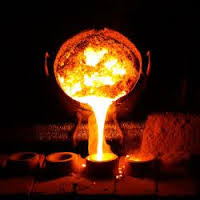 Metallurgy is engaged in the extraction of metals from ores, and alloys, structures and properties (corrosion resistance, tensile strength, conductivity) of metal. Operations like annealing, tempering, molding, welding, soldering, forging and rolling belong to this.
Metallurgy is engaged in the extraction of metals from ores, and alloys, structures and properties (corrosion resistance, tensile strength, conductivity) of metal. Operations like annealing, tempering, molding, welding, soldering, forging and rolling belong to this.
The metallurgy of copper is a very ancient form of chemistry.
Properties of metals
Metals are infinitely recyclable without loss of properties. They are deformable without breaking quickly, have a shiny appearance and conduct heat and electricity well.
Pure metals are always soft and very malleable and therefore unsuitable for construction applications.
Only copper, silver and gold occur in (almost) pure metal (solid) form. Metals are ubiquitous as trace elements in minerals. If the concentration is high enough to win (profitable) metal we call it a mineral ore. The extraction of metal from an ore can via electrochemical processes (at high or low temperature), or (usually) by high-temperature processes (pyrometallurgical) in which crushed ore is heated. Metal extraction always involves a reduction step (via binding to include electrons). Iron is recovered by reduction with carbon, zinc, copper, and aluminum by reduction with electrons.
Two similar processes for extracting metal from ore by transforming it into an oxide ore:
Roasting: a gas - solid reaction at very high temperature and excess air (oxygen)
Calcination: a reaction at high temperature and limited air (oxygen)
Lots of info about metal, (and more)l can be found at
http://www.lenntech.nl/periodiek/elementen/index.htm
An alloy is a "solid solution": means two or more metals are melted together and mixed. A common example is bronze as an alloy of copper and a little tin. The addition of tin makes bronze a lot stronger than copper. Brass (copper and zinc), or steel (iron and carbon) are other examples.
